Dachau Trials
US vs. Martin Gottfried Weiss, et al
In the photograph below, prosecution
witness Michael Pellis identifies SS Hauptscharfürher Franz
Böttger in the courtroom at Dachau during the American Military
Tribunal proceedings in the case of US vs. Martin Gottfried Weiss,
et al. The man wearing a card with the number 34 is Walter Adolf
Langleist.
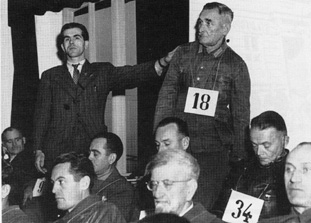
Franz Böttger,
# 18, is identified by a prosecution witness
Franz Böttger was born in 1888 and
was 57 years old at the time of his trial. Between May 1941 and
May 1945, he served as a Rapportführer (Roll call leader)
in the Dachau camp. One of his duties was to escort condemned
prisoners to the crematorium where they were shot or hanged.
At the Dachau trial, Böttger was charged with kicking the
chair out from under a Russian Communist Commissar when he was
hanged. He was also charged with shooting a Russian POW who collapsed
on an evacuation death march out of the Dachau camp on April
27, 1945.
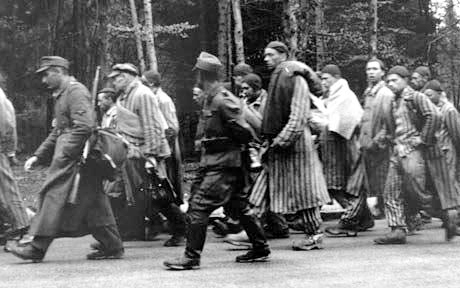
Russian POWs and Jewish
prisoners on evacuation march
The following quote is from the book
entitled "Dachau Liberated The Official Report by the U.S.
Seventh Army, edited by Michael W. Perry":
Bottger, Franz - SS Hauptsharfuhrer
Rapportfuhrer
in the camp, subject is an outstanding example of inhuman
cruelty and brutality. He participated in the killing of many
political prisoners as well as the killing of many prisoners
of war. On 27 April 1945, he left Dachau with an evacuation transport.
Over 1200 people were killed on the way. Subject was recognized
and apprehended by informants working for this detachment about
30 kilometers distance from Dachau.
Franz Trenkle was one of the executioners
at Dachau; he wore card number 4 around his neck during the trial.
Under interrogation by Lt. Paul Guth before the trial began,
Trenkle had confessed to shooting prisoners, convicted of sabotage
and looting, who had been brought to Dachau for execution. Trenkle's
defense was that he was obeying superior orders. The order had
been given by der Führer, Adolf Hitler, and passed down
to Ernst Kaltenbrunner, the head of the SD, who then passed the
order down to SS Lt. Gen. Richard Glücks who gave the order
to Gauleiter Paul Giessler who ordered the shooting. Trenkle
claimed that he could only obey commands and was powerless to
stop the executions.
Rudolf Wolf, a former prisoner at Dachau,
testified that Franz Trenkle was in charge of punishments in
the camp. In the photograph below, Wolf demonstrates how he had
to bend over the whipping block when he was punished at Dachau.
Franz Trenkle was convicted and hanged on May 28, 1946.

Witness demonstrates
the whipping block in the courtroom
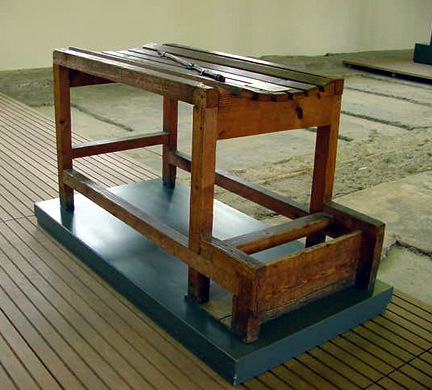
Whipping block on display
in Dachau Museum
Note that the whipping block that was
shown in the courtroom at Dachau was an ordinary wooden table,
not an actual whipping block. The photo above shows the whipping
block on display in the former shower room in the administration
building at Dachau which was converted into a Museum in 1965.
All punishments at Dachau and all the
other concentration camps had to be approved by the WVHA economic
office in Oranienburg, where Rudolf Hoess was a member of the
staff after he was removed as the Commandant of Auschwitz in
December 1943. At the Nuremberg IMT, on April 15, 1946, Hoess
testified that punishment on the whipping block was seldom used
and that this punishment was discontinued in 1942 or 1943 because
Reichsführer Heinrich Himmler gave a new order that the
SS men were forbidden to strike the prisoners. Dr. Johannes Neuhäusler
mentioned in his book entitled "What was it like in the
Concentration Camp at Dachau?" that this order was given
by Himmler in 1942.
The photo below shows Emil Mahl, wearing
number 33. He is standing in the courtroom in Dachau as he is
identified by Rudolf Wolf. Seated on the far right is Albin Gretsch,
number 31.

Wolf points to Emil
Mahl a prisoner at Dachau who was on trial
When Mahl was interrogated in early May
1945 by Michael Thomas, a Jewish agent with the US Counter Intelligence
Corps, he made a handwritten statement in which he confessed
that, as the executioner of the camp, he had hanged 800 to 1,000
people including a pregnant woman. Mahl also confessed that he
was ordered to burn the body of General Charles Delestraint after he was
allegedly executed at Dachau on April 19, 1945, ten days before
the camp was liberated.
Mahl was specifically charged with assisting
in the execution of a young Russian Prisoner of War who was hanged
because Adolf Hitler had ordered, before the invasion of Russia,
that all captured Communist Commissars should be brought to the
nearest concentration camp and executed. Mahl had committed a
war crime when he put the rope around the neck of the Russian
POW before his execution.
Emil Erwin Mahl was defended by Hans
Karl von Posern, a German attorney, who had been a prisoner at
Mauthausen. His defense was that Mahl was only obeying orders:
"Befehl ist Befehl - an order is an order." Pointing
to Emil Mahl behind him, von Posern said, "Here is defendant
Mahl, who was told he had to take part of an execution. He gets
led up to the execution place and receives the order to place
the rope on the neck of a man who shall get hanged. If he had
not obeyed the order, his own execution would have taken place."
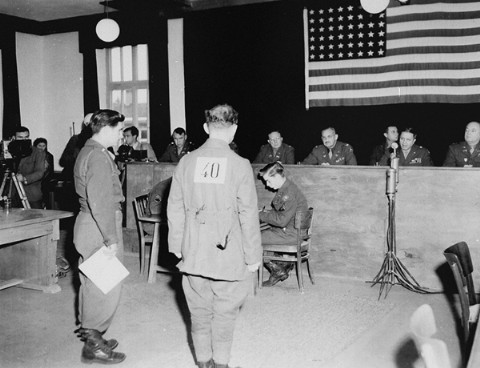
Friedrich Wetzel is
sentenced to death by American Military Tribunal
Friedrich Wetzel, shown in the photo
above, was a pathetic, mild-mannered man who wouldn't hurt a
fly; he was the supply officer in the camp and had not personally
committed any atrocities. In the defense closing argument on
December 12, 1945, Lt. Col. Douglas Bates argued against the
concept of "common design." Bates said the following,
with regard to Friedrich Wetzel, as quoted from the trial transcript:
And a new definition of murder has
been introduced along with common design. This new principle
of law says "I am given food and told to feed these people.
The food is inadequate. I feed them with it, and they die of
starvation. I am guilty of murder." Germany was fighting
a war she had lost six months before. All internal business had
completely broken down. I presume people like Filleboeck and
Wetzel should have reenacted the miracle of Galilee, where five
loaves and fishes fed a multitude."

Friedrich Wetzel, Number
40, is identified by Helmuth Breiding
In the photograph above, SS-Sturmbannführer
Friedrich Wetzel, who was the staff member in charge of food
and clothing, is being identified by a former inmate, Helmuth
Breiding, a prosecution witness. Wetzel is wearing the number
40 on his chest.
The following quote is from the book
entitled "Witness to Barbarism," written by a member
of the prosecution staff at Dachau:
Denson has drawn the indictment alleging
violations of the Rules of Land Warfare - namely, the killings,
beatings, torture, starvation, and other abuses from January
1, 1942, to April 29, 1945, when the Americans liberated Dachau.
He says the worst offense was the starvation of prisoners through
embezzlement. The administration of each camp received a check
by mail from the Himmler headquarters in Berlin, the amount depending
on the number of prisoners. But they bought as little food as
possible for prisoners, pocketing the remainder of the funds.
Karl Otto Koch, the Commandant of Buchenwald,
was accused by the SS of embezzling money from funds given to
the camp; Koch was executed by the SS after a trial conducted
by SS judge Konrad Morgen. Amon Goeth, the Commandant of the
Plaszow camp in the Schindler's List story, was awaiting trial
by the SS when World War II ended; he had been accused by Morgen
of stealing from the warehouses at the Plaszow camp. The Dachau
camp was also investigated by Morgen, but there were no accusation
of embezzlement of funds for food.
Wetzel was not accused of personally
pocketing the funds for the camp food at Dachau, but nevertheless,
as the person in charge of the food, he was found guilty of participating
in the "common plan" to commit war crimes and was sentenced
to death by hanging.
In the same photograph above, which was
taken on November 22, 1945, the man on the far left, wearing
#29 on his chest, is Sylvester Filleböck. One prosecution
witness testified that Filleböck was present in September
1944 when 90 Communist Commissars in the Soviet Army were executed
at Dachau on the orders of Adolf Hitler. Filleböck denied
being present at the execution and six other witnesses corroborated
his story, but nevertheless, he was sentenced to death by hanging.
He was guilty of a violation of the Laws and Usages of War because
he was allegedly present during the executions and had not acted
to intervene.
All German soldiers in both the SS and
the Wehrmacht were required to swear an oath to Adolf Hitler,
not to their country. By not intervening in the executions ordered
by Hitler, Filleböck had prolonged his own life by a few
years, since he would undoubtedly have been shot on the spot
if he had tried to stop an order from being carried out. The
prosecution contended that he would have merely been transferred
to another job.
During closing arguments, defense attorney
Lt. Col. Douglas Bates gave the following argument with regard
to the "superior orders" defense:
There has been a lot of impressive
law read by the chief counsel, and it is good law - Miller, Wharton.
The sad thing is that little of it is applicable law. Perhaps
we have not been diligent enough in seeking applicable law. Some
think the prosecution has found applicable law in the Rules of
Land Warfare on the doctrine of superior orders. We have no intention
of arguing that executions by the German Reich were due process.
Nevertheless, we contend that executions were the result of law
of the then recognized regime in Germany and that members of
the firing squad were simple soldiers acting in the same capacity
as in any military organization in the world.
Leonard Eichberger was a soldier who
was ordered to Dachau after he was wounded at the front and had
lost a leg. Capt. Niles argued before the court that Eichberger
had not had a choice when he was assigned to Dachau and that
he should not be held responsible for the legality of the orders
that he had to carry out in the camp.
On direct examination, the defense attorneys
elicited testimony from several of the accused in which they
claimed to have been tortured by their interrogators. The chief
interrogator who was accused of mistreating the accused men in
the first Dachau trial was Lt. Paul Guth, a Jewish refugee who
had emigrated to America in 1941 from Vienna, Austria.
Dr. Wilhelm Witteler, who was accused
of making leather goods out of human skin, testified that he
signed his confession after being tortured by Lt. Guth. The testimony regarding
the human skin and shrunken heads is contained in the transcripts
of the trial which are on microfilm, kept in the National Archives
in Washington, DC.
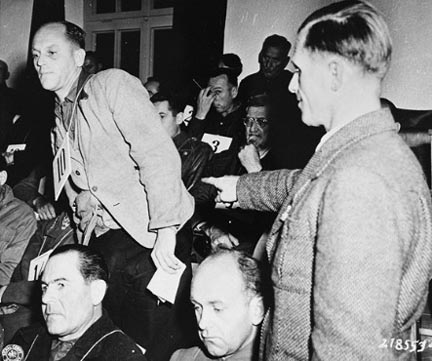
Eugen Seybold identifies
Dr. Fritz Hintermayer in Dachau courtroom
The photograph above shows Dr. Fritz
Hintermayer, on the left, wearing a card with the number 10 around
his neck. Eugen Seybold, a former prisoner in the camp, points
to him as he identifies Dr. Hintermayer as one of the SS doctors
at Dachau. Dr. Hintermayer was one of the accused who claimed
that he was coerced into signing a confession by Lt. Guth. Eugen
Seybold was one of the Kapos at Dachau; he was one of the workers
in the crematorium whose job it was to put the dead bodies into
the cremation ovens. He could potentially have been among the
accused himself if he had not agreed to testify for the prosecution
as a paid witness, as one of the defense attorneys pointed out
during the trial.
Ironically, one of the defendants who
testified that
he was tortured by American military officers was Johann Kick,
who was charged with the specific crime of torturing prisoners
in the Dachau
bunker between January 1, 1942 and April 29, 1945. Kick was
the head of the political department at Dachau from 1937 to 1945.
He testified about being tortured by Jewish interrogators at
Dachau on November 29, 1945, the same day that a film about the
Dachau gas chamber was shown at the Nuremberg IMT. This film
was not shown at the "Dachau trials" because it was
unknown whether any of the victims had been civilians or military
personnel, who were citizens of an Allied country during the
period of time that America was at war with Germany.
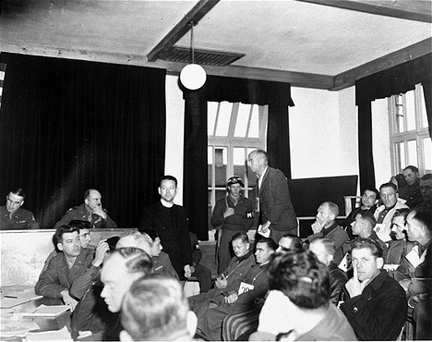
The man standing on
the right is Fritz Becher, a Kapo at Dachau
The photo above shows Fritz Becher in
the courtroom at Dachau, just after he rose from his chair to
take the witness stand.
Lt. Col. William Denson conceded that
Becher might have been falsely accused by one of the witnesses:
"It may be pointed out by defense counsel that some testified
falsely, that on a certain date they saw Becher beat a priest
so brutally that he died, and Becher states he was not at that
place at that particular time. And the witness may indeed be
in error in that respect." Becher was sentenced to death
by hanging; he was executed on May 29, 1946.
Theodore Koch, a Polish priest who was
a Dachau prisoner from October 1941 to April 1945, testified
that the prisoners had to do exercises as punishment. According
to Koch, the prisoners had to jump, do knee-bends, and other
gymnastics, including running on their knees. Koch testified
that from Palm Sunday until Easter Sunday, the priests had to
go through exercises on the roll call place from 6:00 a.m. until
7:00 p.m. except for a break for dinner. Koch claimed that many
priests died during and after these exercises.
The prosecution called over 100 witnesses
to the stand; at the end of his presentation, Lt. Col. Denson
called several of the Jewish interrogators to the stand. All
of them denied using any force or coercion to obtain confessions
from the accused. Supposedly, the accused had voluntarily signed
confessions admitting to the most ignominious atrocities, such
as making human shrunken heads or fashioning handbags out of
human skin, with the knowledge that they would surely receive
a death sentence for such crimes.
Kaufering
Sub-camp
Prosecution Summation
Dachau gas chamber
Opening of the Trial
Martin Gottfried Weiss
Friedrich
Wilhelm Ruppert
Medical
Experiments
Back to Dachau
Trials
Home
This page was last updated on April 6,
2008
Dachau TrialsUS vs. Martin Gottfried Weiss, et alIn the photograph below, prosecution witness Michael Pellis identifies SS Hauptscharfürher Franz Böttger in the courtroom at Dachau during the American Military Tribunal proceedings in the case of US vs. Martin Gottfried Weiss, et al. The man wearing a card with the number 34 is Walter Adolf Langleist.  Franz Böttger was born in 1888 and was 57 years old at the time of his trial. Between May 1941 and May 1945, he served as a Rapportführer (Roll call leader) in the Dachau camp. One of his duties was to escort condemned prisoners to the crematorium where they were shot or hanged. At the Dachau trial, Böttger was charged with kicking the chair out from under a Russian Communist Commissar when he was hanged. He was also charged with shooting a Russian POW who collapsed on an evacuation death march out of the Dachau camp on April 27, 1945.  The following quote is from the book entitled "Dachau Liberated The Official Report by the U.S. Seventh Army, edited by Michael W. Perry": Bottger, Franz - SS Hauptsharfuhrer Rapportfuhrer in the camp, subject is an outstanding example of inhuman cruelty and brutality. He participated in the killing of many political prisoners as well as the killing of many prisoners of war. On 27 April 1945, he left Dachau with an evacuation transport. Over 1200 people were killed on the way. Subject was recognized and apprehended by informants working for this detachment about 30 kilometers distance from Dachau. Franz Trenkle was one of the executioners at Dachau; he wore card number 4 around his neck during the trial. Under interrogation by Lt. Paul Guth before the trial began, Trenkle had confessed to shooting prisoners, convicted of sabotage and looting, who had been brought to Dachau for execution. Trenkle's defense was that he was obeying superior orders. The order had been given by der Führer, Adolf Hitler, and passed down to Ernst Kaltenbrunner, the head of the SD, who then passed the order down to SS Lt. Gen. Richard Glücks who gave the order to Gauleiter Paul Giessler who ordered the shooting. Trenkle claimed that he could only obey commands and was powerless to stop the executions. Rudolf Wolf, a former prisoner at Dachau, testified that Franz Trenkle was in charge of punishments in the camp. In the photograph below, Wolf demonstrates how he had to bend over the whipping block when he was punished at Dachau. Franz Trenkle was convicted and hanged on May 28, 1946.   Note that the whipping block that was shown in the courtroom at Dachau was an ordinary wooden table, not an actual whipping block. The photo above shows the whipping block on display in the former shower room in the administration building at Dachau which was converted into a Museum in 1965. All punishments at Dachau and all the other concentration camps had to be approved by the WVHA economic office in Oranienburg, where Rudolf Hoess was a member of the staff after he was removed as the Commandant of Auschwitz in December 1943. At the Nuremberg IMT, on April 15, 1946, Hoess testified that punishment on the whipping block was seldom used and that this punishment was discontinued in 1942 or 1943 because Reichsführer Heinrich Himmler gave a new order that the SS men were forbidden to strike the prisoners. Dr. Johannes Neuhäusler mentioned in his book entitled "What was it like in the Concentration Camp at Dachau?" that this order was given by Himmler in 1942. The photo below shows Emil Mahl, wearing number 33. He is standing in the courtroom in Dachau as he is identified by Rudolf Wolf. Seated on the far right is Albin Gretsch, number 31.  When Mahl was interrogated in early May 1945 by Michael Thomas, a Jewish agent with the US Counter Intelligence Corps, he made a handwritten statement in which he confessed that, as the executioner of the camp, he had hanged 800 to 1,000 people including a pregnant woman. Mahl also confessed that he was ordered to burn the body of General Charles Delestraint after he was allegedly executed at Dachau on April 19, 1945, ten days before the camp was liberated. Mahl was specifically charged with assisting in the execution of a young Russian Prisoner of War who was hanged because Adolf Hitler had ordered, before the invasion of Russia, that all captured Communist Commissars should be brought to the nearest concentration camp and executed. Mahl had committed a war crime when he put the rope around the neck of the Russian POW before his execution. Emil Erwin Mahl was defended by Hans Karl von Posern, a German attorney, who had been a prisoner at Mauthausen. His defense was that Mahl was only obeying orders: "Befehl ist Befehl - an order is an order." Pointing to Emil Mahl behind him, von Posern said, "Here is defendant Mahl, who was told he had to take part of an execution. He gets led up to the execution place and receives the order to place the rope on the neck of a man who shall get hanged. If he had not obeyed the order, his own execution would have taken place."  Friedrich Wetzel, shown in the photo above, was a pathetic, mild-mannered man who wouldn't hurt a fly; he was the supply officer in the camp and had not personally committed any atrocities. In the defense closing argument on December 12, 1945, Lt. Col. Douglas Bates argued against the concept of "common design." Bates said the following, with regard to Friedrich Wetzel, as quoted from the trial transcript: And a new definition of murder has been introduced along with common design. This new principle of law says "I am given food and told to feed these people. The food is inadequate. I feed them with it, and they die of starvation. I am guilty of murder." Germany was fighting a war she had lost six months before. All internal business had completely broken down. I presume people like Filleboeck and Wetzel should have reenacted the miracle of Galilee, where five loaves and fishes fed a multitude."  In the photograph above, SS-Sturmbannführer Friedrich Wetzel, who was the staff member in charge of food and clothing, is being identified by a former inmate, Helmuth Breiding, a prosecution witness. Wetzel is wearing the number 40 on his chest. The following quote is from the book entitled "Witness to Barbarism," written by a member of the prosecution staff at Dachau: Denson has drawn the indictment alleging violations of the Rules of Land Warfare - namely, the killings, beatings, torture, starvation, and other abuses from January 1, 1942, to April 29, 1945, when the Americans liberated Dachau. He says the worst offense was the starvation of prisoners through embezzlement. The administration of each camp received a check by mail from the Himmler headquarters in Berlin, the amount depending on the number of prisoners. But they bought as little food as possible for prisoners, pocketing the remainder of the funds. Karl Otto Koch, the Commandant of Buchenwald, was accused by the SS of embezzling money from funds given to the camp; Koch was executed by the SS after a trial conducted by SS judge Konrad Morgen. Amon Goeth, the Commandant of the Plaszow camp in the Schindler's List story, was awaiting trial by the SS when World War II ended; he had been accused by Morgen of stealing from the warehouses at the Plaszow camp. The Dachau camp was also investigated by Morgen, but there were no accusation of embezzlement of funds for food. Wetzel was not accused of personally pocketing the funds for the camp food at Dachau, but nevertheless, as the person in charge of the food, he was found guilty of participating in the "common plan" to commit war crimes and was sentenced to death by hanging. In the same photograph above, which was taken on November 22, 1945, the man on the far left, wearing #29 on his chest, is Sylvester Filleböck. One prosecution witness testified that Filleböck was present in September 1944 when 90 Communist Commissars in the Soviet Army were executed at Dachau on the orders of Adolf Hitler. Filleböck denied being present at the execution and six other witnesses corroborated his story, but nevertheless, he was sentenced to death by hanging. He was guilty of a violation of the Laws and Usages of War because he was allegedly present during the executions and had not acted to intervene. All German soldiers in both the SS and the Wehrmacht were required to swear an oath to Adolf Hitler, not to their country. By not intervening in the executions ordered by Hitler, Filleböck had prolonged his own life by a few years, since he would undoubtedly have been shot on the spot if he had tried to stop an order from being carried out. The prosecution contended that he would have merely been transferred to another job. During closing arguments, defense attorney Lt. Col. Douglas Bates gave the following argument with regard to the "superior orders" defense: There has been a lot of impressive law read by the chief counsel, and it is good law - Miller, Wharton. The sad thing is that little of it is applicable law. Perhaps we have not been diligent enough in seeking applicable law. Some think the prosecution has found applicable law in the Rules of Land Warfare on the doctrine of superior orders. We have no intention of arguing that executions by the German Reich were due process. Nevertheless, we contend that executions were the result of law of the then recognized regime in Germany and that members of the firing squad were simple soldiers acting in the same capacity as in any military organization in the world. Leonard Eichberger was a soldier who was ordered to Dachau after he was wounded at the front and had lost a leg. Capt. Niles argued before the court that Eichberger had not had a choice when he was assigned to Dachau and that he should not be held responsible for the legality of the orders that he had to carry out in the camp. On direct examination, the defense attorneys elicited testimony from several of the accused in which they claimed to have been tortured by their interrogators. The chief interrogator who was accused of mistreating the accused men in the first Dachau trial was Lt. Paul Guth, a Jewish refugee who had emigrated to America in 1941 from Vienna, Austria. Dr. Wilhelm Witteler, who was accused of making leather goods out of human skin, testified that he signed his confession after being tortured by Lt. Guth. The testimony regarding the human skin and shrunken heads is contained in the transcripts of the trial which are on microfilm, kept in the National Archives in Washington, DC.  The photograph above shows Dr. Fritz Hintermayer, on the left, wearing a card with the number 10 around his neck. Eugen Seybold, a former prisoner in the camp, points to him as he identifies Dr. Hintermayer as one of the SS doctors at Dachau. Dr. Hintermayer was one of the accused who claimed that he was coerced into signing a confession by Lt. Guth. Eugen Seybold was one of the Kapos at Dachau; he was one of the workers in the crematorium whose job it was to put the dead bodies into the cremation ovens. He could potentially have been among the accused himself if he had not agreed to testify for the prosecution as a paid witness, as one of the defense attorneys pointed out during the trial. Ironically, one of the defendants who testified that he was tortured by American military officers was Johann Kick, who was charged with the specific crime of torturing prisoners in the Dachau bunker between January 1, 1942 and April 29, 1945. Kick was the head of the political department at Dachau from 1937 to 1945. He testified about being tortured by Jewish interrogators at Dachau on November 29, 1945, the same day that a film about the Dachau gas chamber was shown at the Nuremberg IMT. This film was not shown at the "Dachau trials" because it was unknown whether any of the victims had been civilians or military personnel, who were citizens of an Allied country during the period of time that America was at war with Germany.  The photo above shows Fritz Becher in the courtroom at Dachau, just after he rose from his chair to take the witness stand. Lt. Col. William Denson conceded that Becher might have been falsely accused by one of the witnesses: "It may be pointed out by defense counsel that some testified falsely, that on a certain date they saw Becher beat a priest so brutally that he died, and Becher states he was not at that place at that particular time. And the witness may indeed be in error in that respect." Becher was sentenced to death by hanging; he was executed on May 29, 1946. Theodore Koch, a Polish priest who was a Dachau prisoner from October 1941 to April 1945, testified that the prisoners had to do exercises as punishment. According to Koch, the prisoners had to jump, do knee-bends, and other gymnastics, including running on their knees. Koch testified that from Palm Sunday until Easter Sunday, the priests had to go through exercises on the roll call place from 6:00 a.m. until 7:00 p.m. except for a break for dinner. Koch claimed that many priests died during and after these exercises. The prosecution called over 100 witnesses to the stand; at the end of his presentation, Lt. Col. Denson called several of the Jewish interrogators to the stand. All of them denied using any force or coercion to obtain confessions from the accused. Supposedly, the accused had voluntarily signed confessions admitting to the most ignominious atrocities, such as making human shrunken heads or fashioning handbags out of human skin, with the knowledge that they would surely receive a death sentence for such crimes. Kaufering Sub-campProsecution SummationDachau gas chamberOpening of the TrialMartin Gottfried WeissFriedrich Wilhelm RuppertMedical ExperimentsBack to Dachau TrialsHomeThis page was last updated on April 6, 2008 |